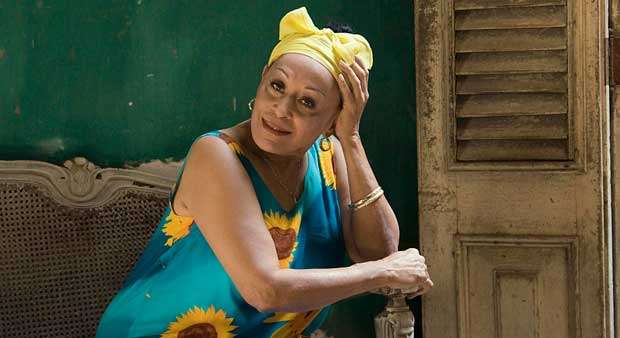Omara comes back again immense, magical and dreamy with her new album entitled My Longing, an album produced by the EGREM, recorded, mixed and mastered in Areíto studio, the oldest in the country.
Fans of the diva of the Buena Vista Social Club, and of Cuban music in general, have in this new work a high quality product, thanks to the repertoire that includes hits that are of the anthology of Latin American and Cuban song making and the challenge that led to its production, and the proven genius of the great singer.
Mis anhelos (original title in Spanish) was the Special Prize winner in the recently concluded edition of Cubadisco, is a double album that includes 21 songs on the excellent vocal work by Omara in duets with emblematic figures of Cuban and world music from incorporating her voice to iconic recordings belonging to the EGREM archives.
With this album “the girlfriend of feeling” finally fulfills herdesire to sing with distinguished performers that shey always admired and enjoyed, but for various reasons never met with her in a study to record the songs collected on this phonogram.
The albums start with the immortal habanera Veinte años, anthology song made out of verses by Guillermina Aramburu that Maria Teresa Vera immortalized, and presented here in a very special version in which Omara herself sings with Vera on the original recording that appears in the LP Echoes of the Past, 1956, with musical accompaniment by the Nene Allué band.
It is pertinent to note that in some tracks the Cuban diva works as a second voice, while in others, as musicologist Grizel Hernandez Baguer, noted “she speaks to the original singers with subtle musical responses between verses and phrases.”
Along with the Vera she also takes on the bolero Porque me siento triste that appears on the 1958 LP, Maria Teresa Vera y su conjunto. Together with her longtime best friend, Elena Burke, Omara sings two songs of worship in the song writing, the first: Alma Libre, with the support of the group All Stars EGREM, and secondly, Mil congojas, accompanied by the orchestra of Rafael Somavilla and registered in an acetate also in the late 1950s.
On the classic line Omara stays when she joins voices with Tito Gómez and the Jorrín Orchestra in the bolero-cha Vereda Tropical, and with the eternal Bola de Nieve in the immortal No puedo ser feliz, by Adolfo Guzman and Mamá perfecta, the latter preceded by Miguel Barnet’s voice reciting his poem Oriki para Bola de Nieve.
The Cuban singer also includes the boleros Esto sí se llama querer, with Miguelito Cuni and Conjunto Niño Rivera, Nunca with Barbarito Diez and Rondalla Venezolana, and Conocí la paz, along with Benny More and his Banda Gigante.
Among the major international figures Omara included in the phonogram are Americans Nat “King” Cole in Quizás, quizás, quizás, cha cha by Cuban Osvaldo Farrés, and the sticky El bodeguero, by Richard Egües, while with Josephine Baker she chose corazón es para ti and Nuestras Vidas, both by the Cuban Orlando de la Rosa.
The King visited Havana in 1958 and recorded the LP Cole, in Spanish with the world famous orchestra of the Tropicana Cabaret, under the direction of Maestro Armando Romeu during the boom of cha cha, so that both titles marked a milestone within the career of the great singer.
For her part, Baker recorded in Havana in 1966, the album Josephine Baker in Havana, with the support of the Musical Theatre Orchestra, conducted by Toni Tano.
In the song writing as a genre several Mexican authors stand by the quality and required intensity of interpreters, Omara went with everything she got and the disc includes Todo y nada, by Vicente Garrido, owner of a well-known work on the island; however from Agustin Lara embargo she chooses theromantic bolero-son La Cumbancha, in which she accompanies Carlos Embale and the Ignacio Piñeiro National Septet on a 1987 recording entitled Clásico del Son.
Danzon, Cuban national dance, is also subject to the desires of Omara, which fuses two works of exceptional national roots as La mora and Virgen de Regla, both by Eliseo Grenet, this time a duet with Barbarito Diez and support of the Orchestra National Symphony.
In the disc, the diva of the Buena Vista Social Club, also adds her voice to Celina González, José Antonio Méndez, Moraima Secada and Carlos Puebla, in what is a vast stage tour of Cuban song that marked the musical trends of the island to this day.
Praise for all the crew that made possible the existence of a gem like Mis anhelos, which demanded a thorough job on the recording, mixing and mastering of each title where they combined girlfriend Omara’s voice with that of the original performers from albums created more than 50 years.
On the same line we must thank Jorge Rodriguez, experienced music producer and author of the original idea, because of his exhaustive investigative work in EGREM files.
Mis anhelos is an album that goes far beyond the wishes of Omara to settle personal artistic debts, is a monument to Cuban music and several of its most important exponents. The unfold ability to assume the dissimilar genres which the album includes and the subtlety with which her voice brings fresh nuances to each performance are only a sample of her greatness as a singer.
Omara, once again has her way, finally fulfills her longing desire to consummate that began a few years ago (2010) with the album Rompiendo la rutina, also with EGREM, where she duets with the great voice of Cuba that was Paulina Alvarez, the Empress of Danzonete.










